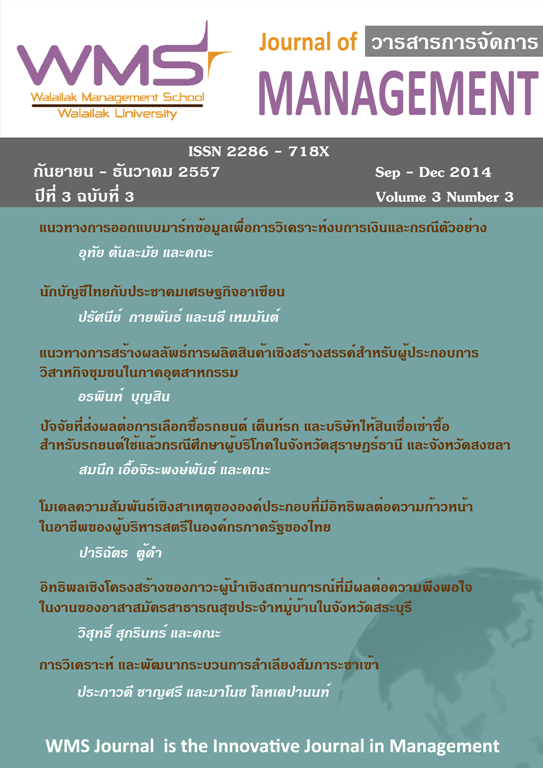Analysis and Improvement of Inbound Baggage Handling Process
Main Article Content
Abstract
Article Details
References
โกศล ดีศีลธรรม. 2551. เพิ่มศักยภาพธุรกิจไทยด้วย Lean Logistics. พิมพ์ครั้งที่ 1. กรุงเทพฯ: ฐานบุ๊คส์.
จอร์จ, ไมเคิล แอล; โรวแลนด์, ดี และแคสเทิล, บี. 2553. What is lean six sigma?. แปลโดย วิทยา สุหฤทดำรง และพรเทพ เหลือทรัพย์สุข กรุงเทพฯ: อี.ไอ. สแควร์.
ชมพูนุท พรหมภักดิ์. 2549. ท่าอากาศยานสุรรณภูมิ ประตูสู่เอเชีย. กรุงเทพฯ: สำนักการพิมพ์ สำนักงานเลขาธิการวุฒิสภา.
ธัชรินทร์ วุฒิชาติ. 2553. การปรับปรุงกระบวนการดำเนินการสำหรับสำนักงานบริหารบุคคล จุฬาลงกรณ์มหาวิทยาลัย. วิทยานิพนธ์ปริญญามหาบัณฑิต ภาควิชาวิศวกรรมอุตสาหการ คณะวิศวกรรมศาสตร์ จุฬาลงกรณ์มหาวิทยาลัย.
นพดล เฟื่องเด่นขจร. 2547. การปรับปรุงความพร้อมในการตอบสนองในอุตสาหกรรมบริการทันตกรรม โดยใช้แนวคิดลีน ซิกซ์ซิกมา: กรณีศึกษา คลินิกบริการทันตกรรมพิเศษ คณะทันตแพทยศาสตร์ จุฬาลงกรณ์มหาวิทยาลัย. วิทยานิพนธ์ปริญญามหาบัณฑิต ภาควิชาวิศวกรรมอุตสาหการ คณะวิศวกรรมศาสตร์ จุฬาลงกรณ์มหาวิทยาลัย.
บุญเลิศ จิตตั้งวัฒนา. 2548. อุตสาหกรรมการบิน และการจำหน่ายตั๋วเครื่องบิน. พิมพ์ครั้งที่ 2. กรุงเทพฯ: เพลส แอนด์ ดีไซน์.
วชิรพงษ์ สาลีสิงห์ และชนรดา อินเที่ยง, บรรณาธิการ. 2549.
ปฏิวัติกระบวนการทำงานด้วยเทคนิค Six sigma ฉบับ Champion และ Black belt. พิมพ์ครั้งที่ 1กรุงเทพฯ: ศิริวัฒนาอินเตอร์พริ้นท์.
สิทธิศักดิ์ พฤกษ์ปิติกุล. 2546. การพัฒนาคุณภาพแบบก้าวกระโดดด้วยวิธี Six Sigma. พิมพ์ครั้งที่ 2. กรุงเทพฯ : สมาคมส่งเสริมเทคโนโลยี (ไทย-ญี่ปุ่น).
Andersen, B. 1999. Business process improvement toolbox. Milwaukee, Wis.: ASQ Quality Press.Andersson, S., Armstrong, A., Bjore, A. et al. 2009. Making medical chemistry more effective – application of Lean Sigma to improve process, speed and quality. Drug Discovery Today Volume 14, Number 11/12: 598 - 604.
Ashford, N., Stanton, H. P. A. and Moore, C. A. 1984. Airport Operations. New York: Wiley.
Carreira, B. and Trudell, B. 2006. Lean Six Sigma that work: a powerful action plan for dramatically improving quality, increasing speed, and reducing waste. New York: AMACOM, American Management Association.
Cime, R. R., Brown, M. J., Hebl, J. R. et al. 2011. Use of Lean and Six Sigma Methodology to improve operating room efficiency in a high volume tertiary - care Academic medical center. The American College of Surgeons: Elsevier.
Evans, J. R. and Lindsay, W. M. 2005. An introduction to Six Sigma & process improvement. Mason, Ohio: Thomson/South-Western.
George, M. L. 2003. Lean six sigma for service: how to use lean speed and six sigma quality to improve services and transaction. New York: McGraw-Hill.
Johnston, R. and Clark, G. 2005. Service operations management: improving service delivery. 2nd ed. Harlow, England: FT/Prentice Hall.
Laureani, A. 2012. Lean Six sigma in the service industry. Advanced Topics in Applied Operations Management: 3 – 14.
Ramasamy, S. 2011. Total quality management. 1st ed. New Delhi: Tata McGraw-Hill.
Raymakers, E., Plessevaux, H., Debande, B. et al. 2009. Improving Patient Process and Cycle Time During Colonoscopy with the Lean and Six Sigma Methodology. Gastrointestinal Endoscopy Volume 69, No. 5: AB230 - AB231.
Robson, G. D. 1991. Continuous process improvement: simplifying work flow systems. New York: The Free Press.
Zinges, C., Gemeinhart., and Babcock. 2009. Analyzing Subcutneous Needlestick Injuries Using Lean Six Sigma Methodology. American Journal of Infection Control: E136 - E137.


